|
|
|
Sort Order |
|
|
|
Items / Page
|
|
|
|
|
|
|
| Srl | Item |
| 1 |
ID:
173117
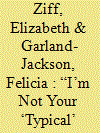

|
|
|
|
|
| Summary/Abstract |
Within the institution and military community, civilian wives of service members occupy complicated roles. On the one hand, wives are undisputedly crucial to the functioning of their service member husbands. However, wives are simultaneously considered subordinate to their husbands within the military and extended community. Indicative of this attitude are the divisive stereotypes of military wives that range from lazy and irresponsible, to overly rank-conscious and entitled. Based on combined in-depth interviews from two samples of military wives, this article investigates how the women navigate the military spouse role within the institutional, community-oriented context of the military. Specifically, we ask, how do these women construct gender and exercise agency when drawing on the stereotypes of wives within the community? By utilizing such mechanisms as symbolic boundary work, gender policing, and stereotyping, women both reify stereotypes of the military spouse and exert agency in creating the military spouse identity for themselves.
|
|
|
|
|
|
|
|
|
|
|
|
|
|
|
|
| 2 |
ID:
105840


|
|
|
| 3 |
ID:
075484
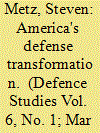

|
|
|
| 4 |
ID:
157493
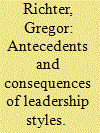

|
|
|
|
|
| Summary/Abstract |
There are numerous studies on the success of various leadership styles that refer to the link between styles and levels of performance and other relevant organizational parameters. Data from a recent survey in a multinational headquarters (HQs) replicate previous findings on leadership style concerning the preferences of the subordinates for more participation in decision-making. Although multinational HQs are in many ways unique organizations that could present unique leadership challenges, too, the findings using traditional models of leadership show how similarly, compared to civilian companies and public administrations, leadership styles are perceived and evaluated by subordinates. Apart from that, the survey data indicate that leadership style—quite different from what was expected—has no significant effect on “organizational commitment” and “mission clarity.” The reasons for that result are discussed against the backdrop of the peculiarities of the organization under investigation.
|
|
|
|
|
|
|
|
|
|
|
|
|
|
|
|
| 5 |
ID:
187106
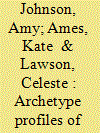

|
|
|
|
|
| Summary/Abstract |
Military spouses are situated at the junction of the military and civilian worlds. They provide necessary support to military strategic and operational objectives and are also expected to perform a traditional spousal role of the ‘good’ military wife. This article demonstrates the existence of strong military partner archetypes which guide military community norms and expectations of spousal behaviour. In 14 qualitative interviews and five focus groups with Australian military partners, participants revealed many different, yet firm, sentiments related to identity, including fierce independence; a sense of belonging; self-reliance; a desire to help others; belief in fairness and pragmatism. The archetypes outlined in this article shape how partners see their role, and how they interact with other non-military partners and the military organization. This research delivers insights into optimizing military partner services to better support spouses through deployment, relocation and other military experiences.
|
|
|
|
|
|
|
|
|
|
|
|
|
|
|
|
| 6 |
ID:
189922
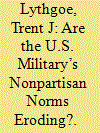

|
|
|
|
|
| Summary/Abstract |
The U.S. military’s nonpartisan norms are an important part of healthy civil–military relations. Some research, however, suggest these norms are weakening. This study examines the evidence for eroding nonpartisan norms by analyzing U.S. military servicemembers’ partisan affiliations and political activism levels from 2008 to 2018. It finds that since 2008, military servicemembers have become more likely to identify as partisans. Servicemembers have also become more politically active than civilians, although this is due to decreasing activism among the American public. It also finds that longer-serving service members have stronger nonpartisan norms, but that newer servicemembers are more politically active than both longer-serving servicemembers and civilians. These findings provide a firmer empirical foundation for previous claims of eroding norms and suggest more research is needed to understand how increased partisanship and political activism impacts military readiness and civil–military relations.
|
|
|
|
|
|
|
|
|
|
|
|
|
|
|
|
| 7 |
ID:
185256
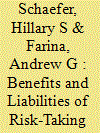

|
|
|
|
|
| Summary/Abstract |
The military environment presents an intersection between a setting featuring unavoidable risk and individual risk-taking propensity; prior work suggests risk-takers have positive and negative outcomes here, and messaging about risk-taking in the military is mixed. The current study used social identity theory to examine how self-reported risk propensity related to three identities/outcomes among cadets at the U.S. Military Academy: attributes of an archetypal “Model Soldier” (physical and military excellence), “Model Student” (grade point average, service positions, and behavior), and Military Values (bravery, duty, and resilience). Structural equation modeling demonstrated that risk-taking was positively related to our Model Soldier and Military Values identities but negatively associated with being a Model Student. Additionally, high-risk-taking cadets were viewed by peers and instructors as confident but prone to judgment, self-discipline, and insight difficulties, suggesting overconfidence among risk-takers. Quantified as a difference between confidence and self-discipline, judgment, and insight, overconfidence mediated the relationship between risk-taking and the three identities, suggesting overconfidence drives both positive and negative associations with risk-taking. Military and leadership implications are presented.
|
|
|
|
|
|
|
|
|
|
|
|
|
|
|
|
| 8 |
ID:
134088


|
|
|
|
|
| Publication |
2014.
|
| Summary/Abstract |
One reason why Europe went to war in 1914 is that all of the continental great powers judged it a favorable moment for them to fight, and all were more pessimistic about postponing the fight until later. Not only is this historical paradox an interesting puzzle in its own right, but it sheds light on what is arguably the reigning theory of the causes of wars in general: James Fearon's rational bargaining theory. None of Fearon's three main mechanisms-private information, commitment problems, or indivisibility of stakes-can explain the paradox of the universal, simultaneous view of 1914 as a favorable year for war. Two mechanisms that play a marginal role in his analysis, however-bounded rationality in multidimensional power assessments and attempts to mitigate power shifts through coercive diplomacy-help to explain how Europe's powers became trapped in a choice between war now and war later. These mechanisms were set in motion by background strategic assumptions rooted in the culture of militarism and nationalism that perversely structured the options facing Europe's political leaders in 1914. Whereas Fearon's theory assumes that states are paying equal attention to all relevant information, in 1914 each power's strategic calculations produced disproportionate levels of self-absorption in its own domestic concerns and alliance anxieties.
|
|
|
|
|
|
|
|
|
|
|
|
|
|
|
|
| 9 |
ID:
183839
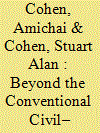

|
|
|
|
|
| Summary/Abstract |
This article modifies the framework for the analysis of civil–military “gaps” proposed in Armed Forces & Society (Vol. 38, 2012) by Rahbek-Clemmensen, Archer, Barr, Belkin, Guerro, Hall, and Swain, who depicted a continuum of four binary fissures (“gap dimensions”) dividing two hypothetically homogeneous communities: civilians versus military personnel. Extrapolating from Israel’s experience, this article instead visualizes a more dynamic and fissured landscape, inhabited by several heterogeneous clusters of population groups, each comprising impromptu coalitions drawn from both the armed forces and civilian society. That environment, we argue, although certainly influenced by the traditional penetrability of Israel’s civil–military boundaries, more directly reflects current technological and cultural processes, which are transforming encounters between civilians and military personnel in other countries too. We therefore suggest replacing the predominantly dichotomous taxonomies that generally characterize studies of civil–military relations in contemporary democratic societies with the fractured format observed in the Israeli case.
|
|
|
|
|
|
|
|
|
|
|
|
|
|
|
|
| 10 |
ID:
188791
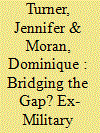

|
|
|
|
|
| Summary/Abstract |
Prior research into military–civilian transition has suggested that the Prison Service may be a popular destination for Armed Forces leavers, but the experience of former military personnel within the prison system as prison staff (rather than as Veterans in Custody) has so far been overlooked. As a result, we know very little about their route into prison work. This article reports on a UK study investigating the experience of prison personnel who have previously served in the military and presents the first set of empirical evidence addressing these critical questions. Whilst our findings mirror prevailing assumptions of a relatively seamless transition to post-military careers (and, in particular, those within Protective Service Occupations), few had intended a career in prison work specifically. Such trajectories may influence personal military–civilian transitions, as well as job performance in prison work and, by extension, the everyday lives of prisoners and other prison staff.
|
|
|
|
|
|
|
|
|
|
|
|
|
|
|
|
| 11 |
ID:
189920
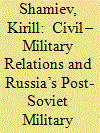

|
|
|
|
|
| Summary/Abstract |
This article studies the role of military culture in defense policymaking. It focuses on Russia’s post-Soviet civil–military relations and military reform attempts. After the fall of the Soviet Union, Russia’s armed forces were in a state of despair. Despite having relative institutional autonomy, the military neither made itself more effective before minister Serdyukov nor tried to overthrow the government. The paper uses the advocacy coalition framework’s belief system approach to analyze data from military memoirs, parliamentary speeches, and 15 interviews. The research shows that the military’s support for institutional autonomy, combined with its elites’ self-serving bias, critically contributed to what I term an “imperfect equilibrium” in Russian civil–military relations: the military could not reform itself and fought back against radical, though necessary, changes imposed by civilian leadership.
|
|
|
|
|
|
|
|
|
|
|
|
|
|
|
|
| 12 |
ID:
088937
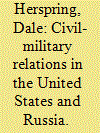

|
|
|
|
|
| Publication |
2009.
|
| Summary/Abstract |
The key to understanding civil-military relations in polities such as Russia and the United States is military culture. Military culture includes a variety of characteristics or norms of behavior. Some such as executive leadership, respect for military expertise, and a clear chain of command are critical and exist in both the American and Russian militaries. Looking at two periods in both countries (Yeltsin and George Bush II, and Putin and George Bush I), this article maintains that in those instances when military culture was ignored in either country (e.g., a lack of executive leadership, little respect for military expertise, and lack of a clear chain of command), conflict not only existed but also was acerbated. Conversely, in cases where the civilians were firmly in charge but respected military culture, conflict was minimized. Senior military officers felt free to express their opinions and had the perception that their views were always taken seriously.
|
|
|
|
|
|
|
|
|
|
|
|
|
|
|
|
| 13 |
ID:
184199
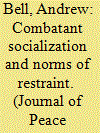

|
|
|
|
|
| Summary/Abstract |
Can armed groups socialize combatants to norms of restraint – in essence, train soldiers to adopt norms of international humanitarian law on the battlefield? How can social scientists accurately measure such socialization? Despite being the central focus of organizational and ideational theories of conflict, studies to date have not engaged in systematic, survey-based examination of this central socialization mechanism theorized to influence military conduct.
This study advances scholarly understanding by providing the first comparative, survey-based examination of combatant socialization to norms of restraint, using surveys and interviews with US Army cadets at the US Military Academy (USMA), Army Reserve Officer Training Corps (ROTC), and active duty Army combatants. Additionally, to better understand ‘restraint’ from combatants’ perspective, this study introduces the concept of the ‘combatant’s trilemma’ under which combatants conceptualize civilian protection as part of a costly trade-off with the values of military advantage and force protection.
Survey results hold both positive and negative implications for socialization to law of war norms: military socialization can shift combatants’ preferences for battlefield conduct. However, intensive norm socialization may be required to shift combatants’ preferences from force protection to civilian protection norms. Study findings hold significant implications for understanding violence against civilians in conflict and for policies to disseminate civilian protection norms in armed groups worldwide.
|
|
|
|
|
|
|
|
|
|
|
|
|
|
|
|
| 14 |
ID:
152317
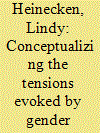

|
|
|
|
|
| Summary/Abstract |
The South African military has adopted an assertive affirmative action campaign to ensure that women are represented across all ranks and branches. This has brought about new tensions in terms of gender integration, related to issues of equal opportunities and meritocracy as well as the accommodation of gender difference and alternative values. The argument is made that the management of gender integration from a gender-neutral perspective cannot bring about gender equality, as it obliges women to conform to and assimilate masculine traits. This affects women’s ability to function as equals, especially where feminine traits are not valued, where militarized masculinities are privileged and where women are othered in ways that contribute to their subordination. Under such conditions, it is exceedingly difficult for women to bring about a more androgynous military culture espoused by gender mainstreaming initiatives and necessary for the type of missions military personnel are engaged in today.
|
|
|
|
|
|
|
|
|
|
|
|
|
|
|
|
| 15 |
ID:
185349
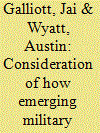

|
|
|
|
|
| Summary/Abstract |
The rapidly emerging scholarly literature responding to autonomous weapon systems has come to dominate our perceptions of future warfare. Scientists, governments, militaries, and civil society organisations continue to debate how to respond to their development. This paper draws on empirical data to consider how emerging defence leaders in the Australian Defence Force perceive major elements and questions within the autonomous weapon system literature. In doing so, this paper offers a data-driven end-user interpretation of the potential interactions between military officers and the autonomous weapon systems they may be asked to oversee. In the absence of a pre-emptive ban under international law, this paper presents a call for greater engagement with junior military leadership as a tool for analysing the assumptions made by policy makers and politicians on this issue.
|
|
|
|
|
|
|
|
|
|
|
|
|
|
|
|
| 16 |
ID:
189932
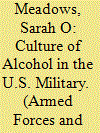

|
|
|
|
|
| Summary/Abstract |
Excessive alcohol use, especially binge and heavy drinking, represents a serious threat to force readiness across the Department of Defense. Though these behaviors are a matter of individual service member choice, they are influenced by perceptions of the culture of alcohol use in the military. This paper uses data from the 2018 Health Related Behaviors Survey of Active Duty service members to explore associations between perceived alcohol culture and excessive alcohol use, any serious drinking consequences, risky driving behaviors, productivity loss due to drinking, absenteeism, and presenteeism. Results from multivariate logistic regression reveal a strong, positive correlation between positive perceptions of drinking culture in the military and all outcomes. Targeting perceptions of the drinking culture is one way the military can reduce excessive and unhealthy use of alcohol and negative sequelae.
|
|
|
|
|
|
|
|
|
|
|
|
|
|
|
|
| 17 |
ID:
186342
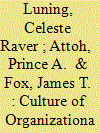

|
|
|
|
|
| Summary/Abstract |
With the backdrop of the utility of grit at the individual level, speculation has begun to circulate that grit may exist as an organizational level phenomenon. To explore this potential construct, this study used an exploratory, qualitative research design. This study explored grit at the organizational level by interviewing leaders’ perceptions of what may be a culture of organizational grit. Participants included 14 U.S. military officers. Seven themes emerged relative to the research question: “What do U.S. military officers perceive as a culture of organizational grit?” Themes included professional pride, team unity, resilience-determination, mission accomplishment, core values, growth mindset, and deliberate practice. This study indicated that a culture of organizational grit is likely a combination of converging organizational elements. Overall, findings indicate that there may be a culture of organizational grit in the military and at the least, more research examining the concept is warranted.
|
|
|
|
|
|
|
|
|
|
|
|
|
|
|
|
| 18 |
ID:
127395
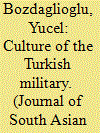

|
|
|
| 19 |
ID:
100141


|
|
|
| 20 |
ID:
177004
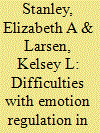

|
|
|
|
|
| Summary/Abstract |
The ability to regulate negative emotions is especially necessary for service members in the contemporary U.S. armed forces, since they routinely face situations that elicit negative emotions while executing their professional roles. Yet difficulties with regulating emotions, which are associated with stress and mood disorders, suicidality, and impairments in work performance, remain prevalent across this group. This article surveys research in five domains—recruitment and selection effects, military cultural pressures and coping strategies, training, common chronic stressors, and the contemporary operational environment—to highlight structural contributors to the heavy stress loads that U.S. service members often bear, which may contribute to their difficulty with emotion regulation (ER). It concludes with several recommendations that the military could implement to mitigate service members’ stress loads and facilitate ER. Enhancing their ER skills may offer a long-term strategy to improve their resilience and performance.
|
|
|
|
|
|
|
|
|
|
|
|
|
|
|
|
|
|
|
|
|